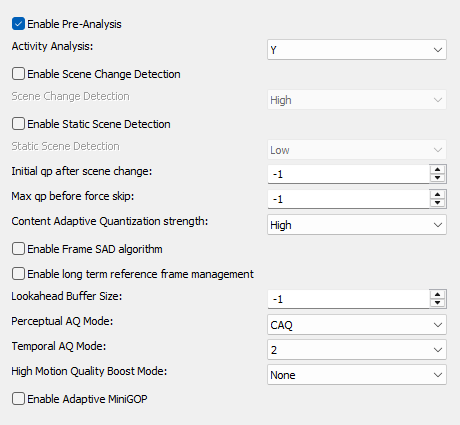AMD AMF H.264 Codec Pre-Analysis
Pre-analysis is an analysis of the video material before the actual encoding. It helps identify video characteristics and select the best encoding process to optimize performance and maximize video quality. This takes advantage of the hardware acceleration of the AMD GPU.

Advertisement
Activity analysis
Specifies whether the activity analysis is performed only for the luma component (Y) or for both luma and chroma (YUV).

Enable Scene Change Detection
Enable Scene Change Detection is a feature in AMD's Advanced Media Framework (AMF) that automatically detects scene changes in a video. When enabled, the codec analyzes the video and identifies when a significant change in image content occurs.

Scene Change Detection
Sets the sensitivity of scene change detection. The higher the sensitivity, the more restrictive the detection of scene changes. This parameter only takes effect when Lookahead Buffer Size is set to 0.

Enable Static Scene Detection
Enable Static Scene Detection is a feature in AMD's Advanced Media Framework (AMF) that helps detect static scenes in video. When enabled, the codec identifies areas in the video that remain unchanged for an extended period of time—so-called "static scenes."

Static Scene Detection
Sets the sensitivity of static scene detection. The higher the sensitivity, the more restrictive the detection of a static scene.

Initial qp after scene change
Initial QP after Scene Change is a setting in the Advanced Media Framework (AMF) that determines the initial quantization parameter (QP) after a scene change. The QP controls the compression strength: a lower value results in better quality, while a higher value increases compression.

Max qp before force skip
Max QP before Force Skip is a setting in the Advanced Media Framework (AMF) that specifies the maximum quantization parameter (QP) before the codec is forced to skip certain frames (force skip).

Content Adaptive Quantization strength
Content Adaptive Quantization Strength is a setting in the Advanced Media Framework (AMF) that adjusts the strength of content-specific quantization during video encoding.
With Content Adaptive Quantization (CAQ), compression is dynamically applied to different parts of the video based on the scene content. Scenes with a lot of motion or detail receive less compression to preserve image quality, while static or less complex scenes receive more compression.

Enable Frame SAD algorithm
Frame SAD (Sum of Absolute Differences) is an algorithm used in AMD's Advanced Media Framework (AMF) to analyze video frames. The SAD algorithm measures the differences between the pixel values of two frames to determine how similar or different they are.
The algorithm is often used to detect motion between frames and to optimize compression.

Enable long term reference frame management
Long-Term Reference Frame Management allows specific frames to be retained as references over longer periods of time. This is particularly useful in scenarios with long-lasting image sequences or stable scenes, as these reference frames can be used across multiple encoding cycles to maximize compression efficiency.

Lookahead Buffer Size
Sets the size of the PA lookahead buffer. The deeper the buffer depth, the better the quality and the longer the latency. Recommended lookahead buffer sizes are 11 (short), 21 (medium), or 41 (long).

Perceptual AQ Mode
Sets the perceptual adaptive quantization mode

Temporal AQ Mode
Applying Temporal AQ Mode makes compression more intelligent and efficient by recognizing how image content changes over time. In scenes with a lot of movement or detail, less aggressive compression settings are used to preserve quality, while in static or less complex scenes, the data is compressed more heavily, resulting in better overall compression.

High Motion Quality Boost Mode
High Motion Quality Boost Mode is a feature in the Advanced Media Framework (AMF) that improves the quality of video encoding in scenes with intense motion. When enabled, this mode allocates more processing power and resources to encoding motion-intensive scenes to achieve higher image quality.

Enable Adaptive MiniGOP
Adaptive MiniGOP is a feature in the Advanced Media Framework (AMF) that optimizes coding efficiency and quality by dynamically adjusting the size of the MiniGOP (Group of Pictures). A MiniGOP consists of a group of video frames that are compressed together, with certain frames serving as reference for compressing the others.

